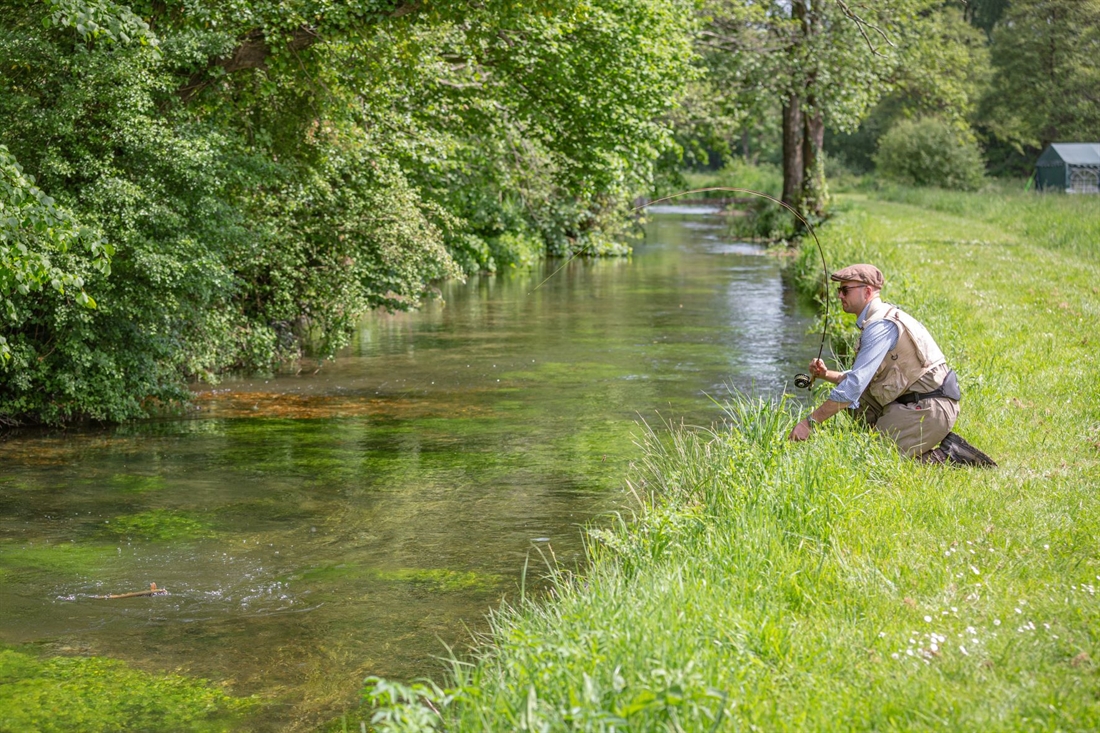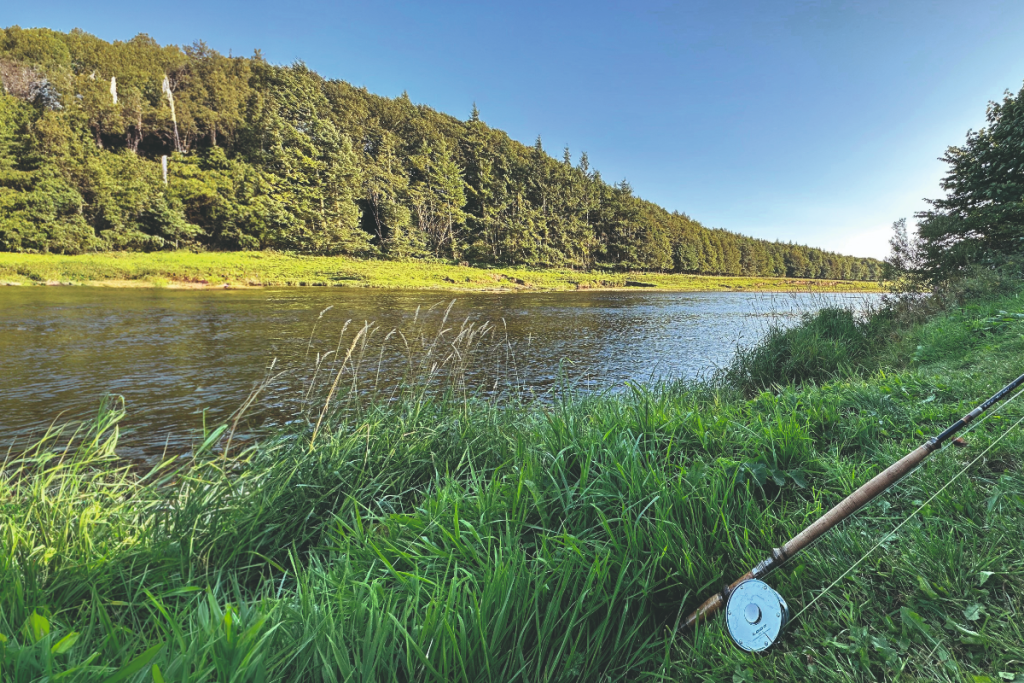Testing times on the Timsbury Beat
Matt Kidd reports on a day’s trout fishing during Duffer’s Fortnight that does not quite play out as expected

As I write, my fly-tying bench is adorned with strips of fur, pheasant tails, fluorescent threads, tungsten beads and some ghastly synthetic materials which I’ve been using to fill my new saltwater fly box and restock my grayling bugs. I find it crazy to think that in just a few months’ time these will be replaced by CDC, hackle feathers and fine wire hooks to imitate natural fly life that’ll hopefully hatch in good numbers in the balmy spring and summer months from sedges and midges to the king of all insects, the mayfly.
Every year I hope to catch a bit of mayfly action as there really are few comparable spectacles in trout fishing, and I can think back to some of my fondest memories where everything has aligned resulting in bonanza days. Occasionally, however, like last year, things don’t go as expected at all and you really have to work for every chance.
The day in question was slap-bang in the middle of ‘Duffers Fortnight’ – a time when trout fishing is considered so easy that any angler can fill their boots with minimal effort due to the prolific mayfly presence. My colleague Gary Turner and I were incredibly lucky to exclusively share Orvis’ Timsbury 5 Beat on the hallowed River Test.
On arrival to our beat we were shown our top and bottom boundaries by Orvis’ Sporting Coordinator Rachael Brady. The beat comprises of just under half a mile of secluded singlebank fishing on the crystal-clear chalkstream and an extra quarter-mile of the equally clear carrier stream. Thanks to the dazzlingly bright conditions we spotted dozens and dozens of handsome trout casting big shadows onto the patchwork of emerald ranunculus and sandy tones of the riverbed. Most importantly, mayfly were dancing above the water in droves.
Sadly, Rachael was not joining us, but left us with four ready-to-go Orvis rods, lines and reels to try if we wanted and suggested a few popular patterns. Eager to get the first fish, both Gary and I were geared up and casting in no time.
However, by the time the sun had reached its zenith we had covered countless fish in the main river of all sizes, but our nets remained frustratingly dry. Fish either sat idly as each offering drifted millimetres from their nose or crashed off upstream with powerful flicks of their tail, spooking every other fish in sight. We tried everything from lengthening the amount of lead above which we would land the fly on the water, hiding in the reeds to hide our silhouettes, extending and lightening the leader, changing flies – you name it.
Unlike us, we decided to stop for a spot of lunch – a sure sign things were difficult – and racked our brains for a conclusion. Maybe conditions were too bright and calm; the river had been over-fished; the trout had already gorged themselves on eclosing mayfly at sun-up; or perhaps a culmination of all three? But we aren’t ones for giving up and heading to the pub, so we worked on a plan. The carrier stream was lined with low hanging branches and foliage on the far bank that most anglers would not target for risk of losing their flies and, therefore, might just offer enough cover for a fish to hide under. Furthermore, there was considerably more flow causing little riffles which would eliminate fly drag, be a little more forgiving on presentation, and also give fish less time to assess our imitations and provoke them into taking.
It worked almost immediately. Fifth cast into the first pool I hooked a superbly strong fish. Sadly, having dropped the tippet to just 2lb Stroft of hair-like diameter, it was sheered by a snag in seconds. If that wasn’t enough, the commotion had forced the handful of other trout nearby to scatter for cover.
In the next pool upstream Gary hooked, landed and released our first fish – we’d avoided the blank! Over the next couple hours we took it in turns to fish and slowly worked our way up the beat, moving a number of surprisingly large fish from some rather unlikely places – under banks, in water just deep enough to cover their backs, roots of trees etc. – and most knew the aquatic environment far better than we ever could, depleting our stock of flies. By 5pm, with three hard-earned fish apiece, we decided it was time to give the main river another go and target some of the brutes that we’d covered earlier.
Of course, like before, the trout just weren’t interested. All of our fish caught in the carrier were on a large French Partridge pattern, which typically fishes slightly subsurface to imitate eclosing mayfly. By this hour in the afternoon, though, we were seeing the odd spinner and little, if any, flies peeling themselves out of the water. We tried more suitable upwing patterns like the Mohican and Green Drake Mayfly but didn’t get so much as a quiver from any brownies, so we applied a little floatant to the French Partridge hackle so it would sit on the surface.
Fished static, it remained a real challenge to even provoke a follow from one of the many 2lb-plus fish that lay sulking at the tail of a pool. After a frustratingly bad cast, I stripped the fly back across the surface to make another when a fish turned and opened its white jaws to engulf the fly just as it left the water – my heart pounded and I cursed as the line tangled around the rod. But I was onto something, and instead of fishing the next cast static, I waited for the fly to be inches in front of a fish and stripped the line enough to make the fly wake over the fish’s nose, resulting in an electrifying take. The tail-walking fight that ensued was incredibly rewarding, and when Gary tried the method next he saw instant success too. We’d finally sussed it out, and stripping the mayfly accross the top made for an unforgettable couple hours of fishing before setting off home.
Related Articles
Get the latest news delivered direct to your door
Subscribe to Fieldsports Journal
Elevate your experience in the field with a subscription to Fieldsports Journal, the premium publication for passionate country sports enthusiasts. This bi-monthly journal delivers unparalleled coverage of game shooting, fishing and big game across the UK and beyond.
Each issue offers a stunning collection of in-depth features, expert opinions and world-class photography, all presented in a timeless yet contemporary design.
Save 10% on shop price when you subscribe, with a choice of packages that work for you. Choose from Print & Digital or Digital only with each journal delivered directly to your door or via the app every other month, plus access to past issues with the digital back issue library.







